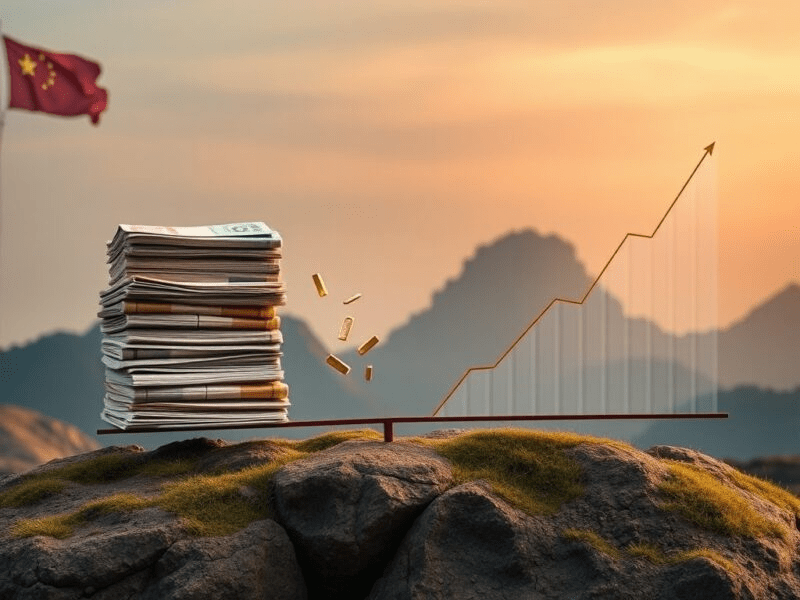based on materials from the website - By ItsBitcoinWorld

In the complex world of global finance, where every economic event can trigger waves in the markets, understanding macroeconomic changes in large economies like China is of paramount importance. Even for those deeply immersed in the rapidly evolving cryptocurrency sphere, these traditional financial trends carry significant weight. They affect investor sentiment, liquidity, and the overall state of the global economy, which in turn can impact the landscape of digital assets. A recent event in China has attracted the attention of analysts worldwide: a slight decrease in its currency reserves, paradoxically occurring against the backdrop of a record trade surplus. This paradoxical scenario requires a deeper analysis of the underlying forces, challenging commonly held beliefs and offering important insights into China's economic strategy and its implications for the world.
To truly grasp the significance of this decline, one must first understand what China's currency reserves are and why they are important. Currency reserves are assets held by a central bank or monetary authority, typically in foreign currencies, gold, and other financial instruments. They serve as a crucial buffer against external shocks, help maintain currency stability, and facilitate international trade and investment. China possesses the largest currency reserves in the world, reflecting its powerful export-oriented economy for decades.
Recently, China's State Administration of Foreign Exchange (SAFE) reported a slight decrease in these reserves. While the overall amount may seem insignificant in the context of trillions of dollars, many are puzzled by the direction of the changes, especially against the backdrop of high trade figures. This decrease, even if small, indicates a more complex dynamic than a simple calculation of inflows and outflows.
Several factors may contribute to a reduction in currency reserves even with a positive trade balance:
Valuation effects: A significant portion of China's reserves is held in currencies other than the US dollar (such as euros, yen, or pounds sterling) and in foreign bonds. Fluctuations in exchange rates of these currencies against the US dollar or changes in the market value of bonds due to interest rate fluctuations can affect the value of reserves expressed in dollars. For example, if the euro weakens against the dollar, the dollar value of China's euro-denominated assets will decrease.
Outbound investments: Chinese companies, including state-owned enterprises and private companies, are increasingly investing abroad. These direct and portfolio investments require converting yuan into foreign currency, leading to a depletion of the country's currency reserves.
Debt repayment: Chinese banks and companies may repay debts denominated in foreign currencies, which also consumes currency reserves.
Interventions to stabilize the yuan's exchange rate: Although the People's Bank of China (PBOC) is unlikely to be the primary cause of a slight decrease during a period of strong trade surplus, it may intervene in the currency market to manage the strengthening or weakening of the yuan. If the yuan is appreciating too quickly due to a trade surplus, the PBOC may sell yuan and buy foreign currency, thus increasing reserves. Conversely, if it wants to slow down depreciation, it may sell foreign currency (using reserves) to buy yuan.
Thus, the recent decline is not necessarily a sign of weakness but rather reflects these multifaceted financial flows and valuation adjustments occurring beneath the surface of key trade indicators.
China's economic engine has long relied on its impressive export potential, making it a key player in the dynamics of global trade. Recently, the country announced a record trade surplus, indicating a significant lead of exports over imports. Generally, a large trade surplus means that more foreign currency is coming into the country from the sale of goods and services abroad than is going out to pay for imports. This inflow of foreign currency typically leads to an accumulation of currency reserves.
So why is there a gap? China's positive trade balance has been supported by strong global demand for Chinese industrial goods, particularly electronics, machinery, and textiles. Despite adverse factors in the global economy, Chinese factories continued to produce goods, reinforcing the country's position as the world's factory. However, the mechanism by which this inflow of foreign currency is transformed into currency reserves is not always straightforward. Foreign currency earned by Chinese exporters is initially held in commercial banks. These banks then either convert it into yuan (which usually leads to the PBOC accumulating additional foreign currency) or may hold it or even use it for their own foreign currency needs, such as lending or investing abroad.
The record positive trade balance underscores China's resilience in manufacturing and its crucial role in global supply chains.
$BTC , $XRP , $BNB
#Сryptomarketnews , #TrumpTariffs
Here, in one news feed, we gather and publish the freshest and most interesting news from more than a dozen news websites and print publications regarding changes in the cryptocurrency market and global financial changes!!!
Welcome to us! There are enough news for everyone!!! 😉


